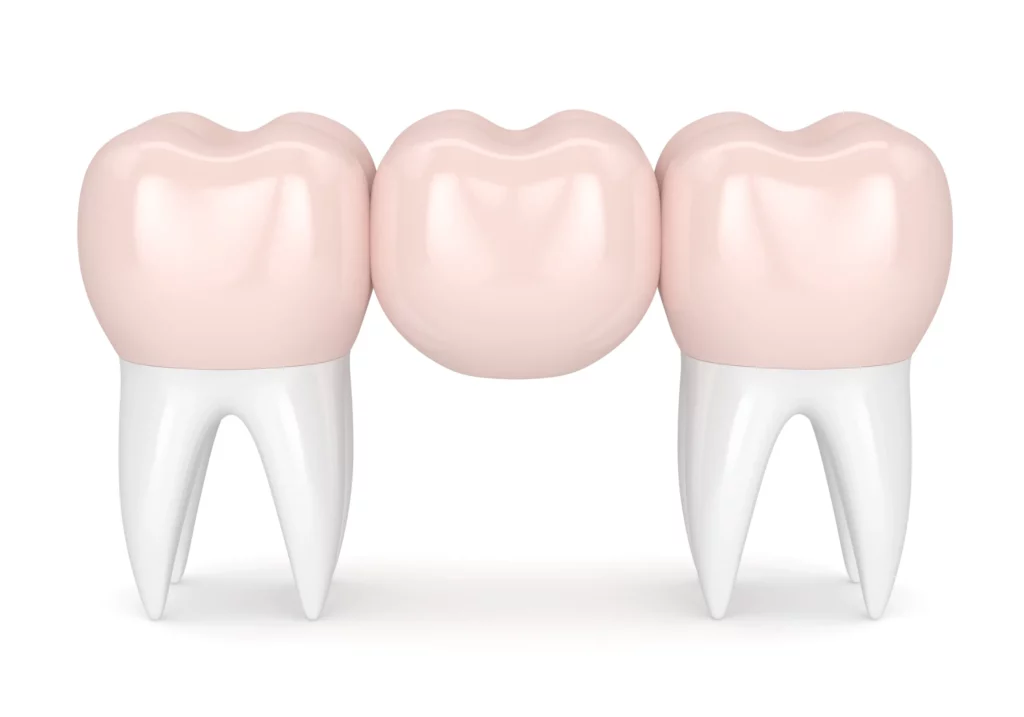Dental Bridges
Restoring Smiles, Enhancing Lives

Everything About
Dental Bridges In Fairfield, CA
What Are Dental Bridges?
A dental bridge is a dental restoration designed to replace one or more missing teeth. It is anchored to the teeth adjacent to the gap, known as abutment teeth, utilizing dental crowns that are connected with an artificial tooth, or pontic, hovering in between.
Who Needs Dental Bridges?
If you have lost one or more natural teeth, a dental bridge could be an excellent solution for you. A bridge not only restores your natural smile but also improves your ability to chew and speak. However, as the number of missing teeth increases, dental bridges may become less practical.
Teeth function in harmony with each other. When a tooth is missing, adjacent teeth may shift into the vacant space, and teeth in the opposite jaw could also move up or down toward the gap. This displacement can lead to various issues, including:
1. Bite irregularities.
2. Chewing difficulties.
3. Pain due to increased stress on your teeth and jaw.
4. Self-consciousness about your appearance or smile.
Consulting with your dentist will help you determine the best course of action for your individual situation, ensuring you select the most effective solution to address your dental concerns and restore your oral health.
Types Of Dental Bridges
Dental bridges come in a variety of types to suit different needs and preferences. The four main types of dental bridges include traditional dental bridges, cantilever bridges, Maryland bonded bridges, and implant-supported bridges. Traditional dental bridges are the most common and involve a false tooth (pontic) held in place by two dental crowns placed over the adjacent natural teeth (abutment teeth), making them an excellent option for patients with healthy teeth on either side of the gap. Cantilever bridges, on the other hand, only require a single crown for support, making them suitable for cases where only one natural tooth is available next to the missing tooth gap. Maryland bonded bridges utilize a metal or porcelain framework with wings that are bonded to the back of the adjacent teeth, offering a less invasive approach as they don’t require crowns or tooth reduction. Lastly, implant-supported bridges are anchored by dental implants, providing superior stability and longevity. This type of bridge is ideal for patients missing multiple teeth in a row or those with a weakened jawbone, as it helps preserve bone structure and offers a long-lasting solution.
Dental Bridge Procedure
During a traditional dental bridge procedure, expect at least two appointments:
1. Abutment Teeth Preparation: In the first appointment, your dentist will reshape the abutment teeth by removing some enamel and dentin to make space for the crown.
2. Dental Impressions: Your dentist will take impressions or a digital scan of your teeth for the dental lab to create your custom bridge, false teeth, and crowns. You’ll receive a temporary bridge to protect exposed areas while awaiting the permanent bridge.
3. Permanent Bridge Fitting: In the second appointment, your dentist will remove the temporary bridge and place the permanent one, ensuring a comfortable fit and making any necessary adjustments.

5 Reasons To Get Dental Bridges
- Restored function: easy eating and speaking
- Enhanced aesthetics: improved smile, confidence boost
- Prevent tooth drift: maintain alignment, fill gaps
- Preserve facial structure: support natural shape, avoid aging
- Durable solution: long-lasting oral health with proper care

5 Reasons To Get Dental Bridges
- Restored function: easy eating and speaking
- Enhanced aesthetics: improved smile, confidence boost
- Prevent tooth drift: maintain alignment, fill gaps
- Preserve facial structure: support natural shape, avoid aging
- Durable solution: long-lasting oral health with proper care
How can we help you?
Frequently Asked Questions
With proper oral hygiene and routine checkups, dental bridges can last between 5 to 15 years, or even longer. It’s not uncommon for a well-maintained dental bridge to last for more than a decade.

